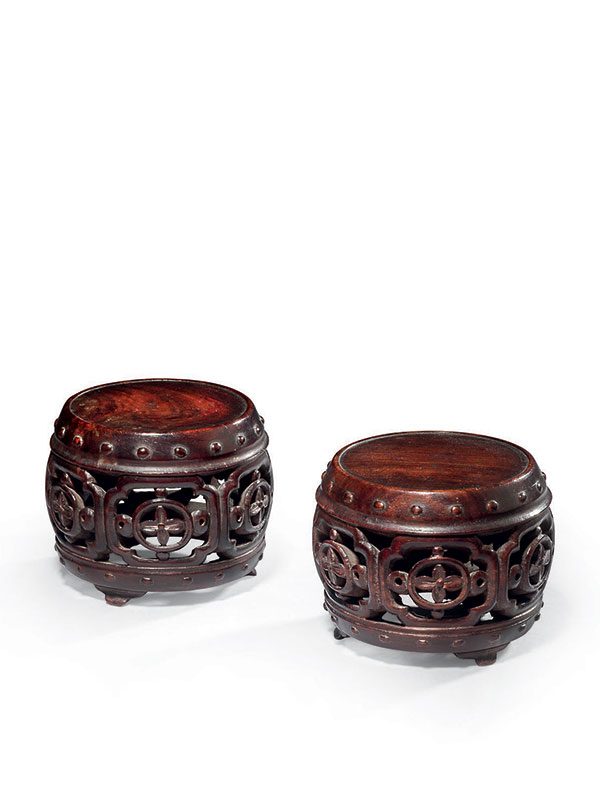Two miniature hardwood stools
Two miniature hardwood stools of drum shape, each supported on three short splayed feet. The circular top is flat and has a beaded edge. The round body is carved in openwork with six ruyi patterns containing circular and floral motifs. A frieze decorated with continuous bosses encircles the upper and lower borders of the body. The wood is well polished and well patinated.
These charming pieces, each carved from a single piece of hardwood, are miniature versions of the barrel-form drum stools known in Chinese as zuodun (literally ‘sitting stool’) or xiudun (‘embroidery stool’). The term xiudun derives from the old practice of covering the seats of stools with embroidered panels both to protect the clothing of the sitter and to enhance the overall appearance. Such practice ceased ultimately, but developed into a tradition of carving designs of fabric panels on the stool bodies, such as the examples here. The bosses or simulated nail-heads on the upper and lower borders are derived from early Chinese drums with skin that were stretched tight and held in place by nails. The form of such drums is very similar to this type of barrel-form stools, whose origin is confirmed by its other name, gudun, or drum stool.[1] There is no evidence for a tradition of making models for patrons to order furniture in China, so miniature pieces such as the present examples were most likely fashioned as ’toys’ for patrons of cabinet makers; they could also be used as stands for precious objects.[2] Apart from the extremely rare Ming and Qing examples of full-scale barrel-form stools, there is no comparable miniature version, to our knowledge. In design, form and proportions, these miniature pieces might have derived from full-scale stools dated to the 17th century of the Ming dynasty: two huanghuali examples are in the collection of the Honolulu Academy of Arts.[3] A further comparable full-scale zitan stool, of more slender shape, is in the collection of the Palace Museum, Beijing.[4]
Provenance: the collection of Louise Hawley Stone (1904 – 1997), Toronto, Canada. She was the Royal Ontario Museum’s first volunteer, and was also a major donor, fundraiser, Board member and committee chair.
1 Wang, Shixiang, Connoisseurship of Chinese Furniture- Ming and Early Qing Dynasties, Vol. I: Text, Art Media Resources, Hong Kong, 1990, p. 34
2 Yip, Sing Yiu and Bruce, G. Wu, Chan Chair and Qin Bench- The Dr. S. Y. Yip Collection of Classic Chinese Furniture II, Art Museum, The Chinese University of Hong Kong, 1998, p. 156
3 Ellsworth, R. H. Chinese Hardwood Furniture in Hawaiian Collections, Honolulu Academy of Arts, Hawaii, 1982, nos. 86, 87, p. 95
4 Zhu, J. J. The Complete Collection of Treasures of the Palace Museum: Furniture of the Ming and Qing Dynasties, vol. I, Hong Kong, 2002, no. 78, p. 89
迷你硬木繡墩兩件
清 十九世紀
寬:8 公分 高:6.7 公分
微型硬木繡墩兩件,各以整木鑿空透雕而成,下承三矮足。弧形側面上下各飾以卯釘狀凸起一道,狀 似鈴鼓,故又得名「鼓墩」。六道透雕如意雲紋環腹,意在摹仿織繡品覆蓋墩座之雅。繡墩為傳統中 國女性的專屬坐具,其圓潤秀美之氣韻,於此組迷你器上仍忠實展現,應為珍玩器或作為陳設珍寶之 基座使用。全尺寸繡墩可見於北京故宮博物院收藏,迷你器則尚無已知他例。

